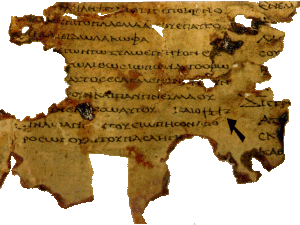Kaige revision

The kaige revision, or simply kaige, is the group of revisions to the Septuagint made[when?] in order to more closely align its translation with the proto-Masoretic Hebrew.[1] The name kaige derives from the revision's pervasive use of Koinē Greek: και γε [kai ge] ("and indeed") to translate the Hebrew: וְגַם [wə gam] ("and also").[2]
The importance of this revision lies in its status as a precursor to later revisions by 'the Three' (i.e., Aquila, Symmachus and Theodotion) as well as the light it sheds on the origins of the Septuagint.[2]
The individual revisions characteristic of kaige were first observed by Dominique Barthélemy in the Greek Minor Prophets Scroll from Nahal Hever.[3] According to Arie Van Der Kooij "his thesis about the K[aige] T[ranslation] has been widely accepted, but his dating of Theodotion before Aquila has not."[4]
Tetragrammaton
[edit]Ellis R. Brotzman and Eric J. Tully claim that a characteristic of the kaige translation is that it wrote YHWH in paleo-Hebrew script instead of translating it into Greek.[5] When referring to kaige recension in 8HevXII gr, Kristin De Troyer makes the following affirmation: "The problem with a recension is that one does not know what is the original form and what the recension. Hence, is the paleo-Hebrew Tetragrammaton secondary – a part of the recension – or proof of the Old Greek text? This debate has not yet been solved."[6]
Influence on the New Testament
[edit]Emanuel Tov wrote that "in some book of the New Testament and in early Christian literature, Hebraizing revisions of the OG often were quoted rather than the OG version itself, reflecting the beginning of the decline of the LXX (the OG) in Judaism".[7] According to Tuukka Kauhanen, the authors of the New Testament could too know a kaige type Septuagint text.[8] Some scholars have exposed different views to explain why in citation of Zechariah 12:10 in John 19:37 "with known forms of the text reveals that it demonstrates many similarities with the Hebrew Masoretic text",[9] which includes Martin Hengel who "speak of possibly identifying John's citation with... 8HevXII gr.[9]: 4–5 Tov also wrote that D. A. Koch has shown that in his letters, Paul sometimes "refers to recensions of the Old Greek towards a proto-Masoretic text."[10]
See also
[edit]References
[edit]- ^ Dines, Jennifer Mary (2004). The Septuagint: Understanding the Bible and Its World. London: A&C Black. p. 81-82. ISBN 9780567084644.
- ^ a b Law, Timothy Michael (2013). When God Spoke Greek: The Septuagint and the Making of the Christian Bible. Oxford: Oxford University Press. p. 76. ISBN 9780199344338.
- ^ Tov, Emanuel (2011). Textual Criticism of the Hebrew Bible. Minneapolis: Fortress Press. p. 143. ISBN 9781451403299.
- ^ Van Der Kooij, A. (1983). "On the Place of Origin of the Old Greek of Psalms". Vetus Testamentum. 33 (1): 67–7. doi:10.2307/1517994. hdl:1887/10615. JSTOR 1517994.
- ^ Ellis R. Brotzman; Eric J. Tully (2016). Old Testament Textual Criticism: A Practical Introduction (2 ed.). Baker Academic. ISBN 9781493404759.
- ^ De Troyer, Kristin (February 2007). "The Names of God. Their Pronunciation and Their Translation. A Digital Tour of Some of the Main Witnesses". European Electronic Journal for Feminist Exegesis. 2.
- ^ Emanuel Tov (2008). Hebrew Bible, Greek Bible and Qumran: Collected Essays. Mohr Siebeck. p. 365. ISBN 9783161495465.
- ^ Tuukka Kauhanen (2017). Anneli Aejmelaeus, Tuukka Kauhanen (ed.). The Legacy of Barthelemy: 50 Years After Les Devanciers D'Aquila. V&r Academic. ISBN 978-3525540626.
- ^ a b Hengel, Martin (2012). "1. Introduction John, LXX and MT". The Fourth Gospel and the Scriptures: Illuminating the Form and Meaning of Scriptural Citation in John 19:37. Translated by Biddle, Mark E. BRILL. pp. 1–5. ISBN 9789004229143.
- ^ Tov, Emanuel (2009). Armin Lange; Matthias Weigold; József Zsengellér (eds.). From Qumran to Aleppo: A Discussion with Emanuel Tov about the Textual History of Jewish Scriptures in Honor of His 65th Birthday. Forschungen zur Religion und Literatur des Alten und Neuen Testaments. Vol. 230. Vandenhoeck & Ruprecht. p. 61. ISBN 9783525530948.
Further reading
[edit]- Timothy Michael Law, When God Spoke Greek, Oxford University Press, 2013.
- Natalio Fernandez Marcos "The B-text of Judges: Kaige Revision and Beyond", in After Qumran. Old and Modern Editions of the Biblical Text – The Historical Books, Edited by H. Ausloos, B. Lemmelijn, J. Trebolle Barrera. BETL 246. Lovaina-Paris-Walpole MA, Peeters 2012, 161–170.
